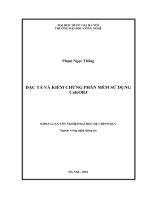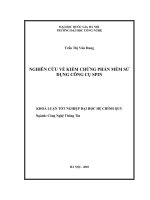Báo cáo môn Kiểm chứng phần mềm : Performance Testing
Bạn đang xem bản rút gọn của tài liệu. Xem và tải ngay bản đầy đủ của tài liệu tại đây (364.54 KB, 23 trang )
Performance Testing
Software Testing
GVHD: Nguyễn Đăng Khoa
Nguyễn Thăng Long 07520198
Lê Tự Thạch Sinh 07520302
Lê Võ Thanh Hồng 09520102
Nguyễn Đình Trọng Đức 09520069
Trần Anh Tuấn 09520450
Performance Testing
Introduction to Performance Testing
Difference between Performance, Load and Stress Testing
Why Performance Testing?
When is it required?
What should be tested?
Performance Testing Process
Performance Testing Tools
Introduction to Performance Testing
Performance testing is the process of determining the speed or effectiveness of a computer, network,
software program or device.
Some terms
•
Throughput
•
Response Time
•
Benchmarking
Throughput
•
Capability of a product to handle multiple
transactions in a give period.
•
Throughput represents the number of
requests/business transactions processed by
the product in a specified time duration.
Response Time
•
The elapsed time between the end of an
inquiry or demand on a computer system and
the beginning of a response
Benchmarking
•
Benchmarking is the process of comparing
one's business processes and performance
metrics to industry bests and/or best practices
from other industries
•
A very well-improved performance of a product
makes no business sense if that performance
does not match up to the competitive products.
Difference between
Performance, Load and Stress Testing
Performance Tesing
•
The testing to evaluate the response time
(speed), throughput and utilization of system
to execute its required functions in comparison
with different versions of the same product or
a different competitive product is called
Performance Testing.
Difference between
Performance, Load and Stress Testing
Load Testing
•
Process of exercising the system under test by
feeding it the largest tasks it can operate with.
•
Constantly increasing the load on the system
via automated tools to simulate real time
scenario with virtual users.
Difference between
Performance, Load and Stress Testing
Stress Testing
•
Trying to break the system under test by
overwhelming its resources or by taking
resources away from it.
•
Purpose is to make sure that the system fails
and recovers gracefully.
Why Performance Testing
Zing Me
•
70K status updated, 400K pictures uploaded, 600K comment committed for every a day.
Zing MP3
•
1.8M uniq visitors, > 20M pageviews for every a day.
How did you think they performed ?
Why Performance Testing
Identifies problems early on before they become costly to resolve.
Reduces development cycles.
Produces better quality, more scalable code.
Prevents revenue and credibility loss due to poor Web site performance.
Enables intelligent planning for future expansion.
To ensure that the system meets performance expectations such as response time, throughput etc.
under given levels of load.
Expose bugs that do not surface in cursory testing, such as memory management bugs, memory
leaks, buffer overflows, etc.
When is it required?
Design Phase:
Pages containing lots of images and multimedia for reasonable wait times. Heavy loads are less
important than knowing which types of content cause slowdowns.
Development Phase:
To check results of individual pages and processes, looking for breaking points, unnecessary code
and bottlenecks.
Deployment Phase:
To identify the minimum hardware and software requirements for the application.
What should be tested?
•
High frequency transactions: The most frequently used transactions have the potential to impact
the performance of all of the other transactions if they are not efficient.
•
Mission Critical transactions: The more important transactions that facilitate the core objectives of
the system should be included, as failure under load of these transactions has, by definition, the
greatest impact.
•
Read Transactions: At least one READ ONLY transaction should be included, so that performance
of such transactions can be differentiated from other more complex transactions.
•
Update Transactions: At least one update transaction should be included so that performance of
such transactions can be differentiated from other transactions.
Performance Testing Process
Performance Testing Process
Planning
•
Determine the performance testing objectives
•
Describe the application to test using a application model
1. Describe the Hardware environment
2. Create a Benchmark (Agenda) to be recorded in Phase 2.
A. Define what tasks each user will perform
B. Define (or estimate) the percentage of users per task.
Performance Testing Process
Record
•
Record the defined testing activities that will be used as a foundation for your load test scripts.
•
One activity per task or multiple activities depending on user task definition
Modify
•
Modify load test scripts defined by recorder to reflect more realistic Load test simulations.
•
Defining the project, users
•
Randomize parameters (Data, times, environment)
•
Randomize user activities that occur during the load test
Performance Testing Process
Creating the scenario
Virtual Users (VUs): Test Goals
Start: 5 Max Response Time <= 20 Sec
Incremented by: 5
Maximum: 200
Think Time: 5 sec
Test Script:
One typical user from login through completion.
Performance Testing Process
Monitoring the scenario
•
We monitor scenario execution using the various online runtime monitors.
Analysing test results
•
During scenario execution, the tool records the performance of the application under different
loads. We use the graphs and reports to analyse the application’s performance.
Performance Testing Tools
Manual testing Limitations
Benefits of Automation
Tools used for Performance Testing
Manual testing Limitations
•
Do you have the testing resources?
•
How do you coordinate and synchronize
users?
•
How do you collect and analyze
results?
Testers
Load Generation
Benefits of Automation
Load Generation
System Under Test
Web server
Database server
Vuser host
•
Controller manages the virtual users
•
Analyze results with graphs and reports
•
Replaces testers with virtual users
Solves the resource limitations
•
Runs many Vusers on a few machines
Analysis
Controller
Tools used for Performance Testing
Open Source
•
OpenSTA
•
Diesel Test
•
ab
•
httperf
Commercial
•
LoadRunner
•
Silk Performer
Thank you
Q&A









